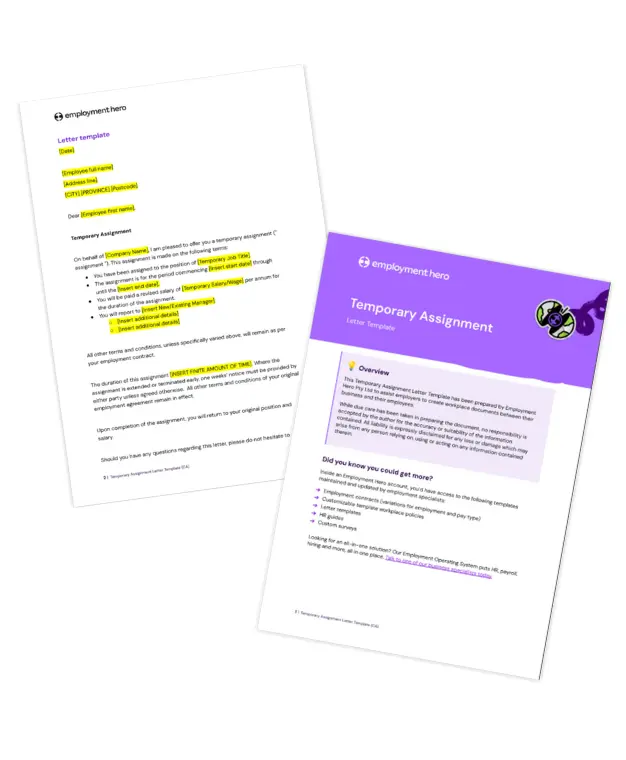Temporary assignment letter template for Canadian employers
Published
Temporary assignment letter template for Canadian employers
Published
A temporary assignment letter is a formal document from an employer to a current, permanent employee outlining the terms and conditions of a short-term, temporary change to their regular job duties or position.
It’s used when an employee is asked to take on different responsibilities, a new role or a specific project for a defined period of time. This is a crucial document because it ensures clarity and mutual agreement regarding the temporary changes. It protects both the employer and the employee by clearly documenting how the assignment affects pay, duration, preventing potential disputes over compensation or job security.

What is a temporary assignment?
In simple language, a temporary assignment is when a permanent employee is moved into a different role, set of duties or project for a finite and predetermined amount of time. This differs from a permanent promotion or transfer, as the employee is expected to return to their original position and salary once the assignment concludes.
When do employers need one?
Employers typically use a temporary assignment letter in common situations such as:
- Covering a leave of absence: Filling in for a colleague on maternity leave, long-term illness or other extended leave.
- Special projects: Assigning an employee to a new, time-limited project (e.g., system upgrade, office relocation, market research).
- Testing a new role: Allowing an employee to “try out” a new, potentially permanent position before committing to a full change.
- Skill development: Providing an employee with a developmental opportunity to gain new skills and experience in a different area of the business.
- High-volume periods: Temporarily shifting an employee to an area experiencing a seasonal or unexpected surge in workload.
Temporary assignments: Legal requirements in Canada
In Canada, employment law is governed by both federal and provincial/territorial legislation. Most private sector employees fall under provincial or territorial laws, specifically the Employment Standards Act (ESA) (or equivalent legislation) in each jurisdiction.
Key legal considerations
When handling internal temporary assignments (where a current employee is moved), employers must be mindful of:
- Written documentation: While not always mandatory, having a written agreement (the temporary assignment letter) is a best practice. It protects against claims of “constructive dismissal” by showing the employee consented to the temporary change in duties, pay or location.
- Maintaining statutory rights: The employee retains all minimum rights under the applicable provincial/territorial Employment Standards Act, including rights related to vacation pay, public holidays, minimum wage and statutory leaves.
- Compensation: If the temporary role is a higher position, most organizations will offer a higher rate of pay or a “pay premium” (often called acting pay or a secondment allowance) for the duration of the assignment. This should be clearly stated.
- Termination/Early end: The letter must clearly outline the conditions for ending the assignment early, including the required notice period. If the assignment ends early, the employee’s original position should still be available to them.
Note on Jurisdiction: For the majority of Canadian employers, the rules will be set by the provincial/territorial Employment Standards Act (e.g., the Employment Standards Act, 2000 in Ontario or the Labour Standards Code in Nova Scotia). The Canada Labour Code only applies to federally regulated industries (e.g., banks, inter-provincial transportation and telecommunications). Always consult the specific legislation for your province or territory.
What should you include in a temporary assignment letter?
To manage compliance and clarity, a well-drafted temporary assignment letter should cover the following key components:
1. Employee and employer information
Clearly state the full legal name, address and contact information for both the employee and the employer (company).
2. Assignment term and dates
Specify the exact start date (e.g., commencing January 1, 2026) and the exact end date (e.g., through until June 30, 2026). If the end date is subject to change, include a clause addressing extensions or early termination.
3. Temporary role, reporting structure and duties
Identify the Temporary Job Title and the name and title of the Manager the employee will report to during the assignment. Provide a brief description of the new duties, or refer to an attached document if the new role has a detailed job description.
4. Compensation and benefits
This is a critical section. Detail the Temporary Salary/Wage for the duration of the assignment. Specify if this pay includes an “acting pay” premium. Confirm that all other benefits (e.g., health benefits, pension contributions) will remain unchanged as per the original employment contract.
5. Return to original position
Include an explicit statement confirming that upon completion of the assignment, the employee will return to their original position and salary (e.g., “Upon completion of the assignment, you will return to your original position of [Original Job Title] and your original salary of [Original Salary]”). This is the core element that defines the assignment as temporary.
6. Entirety of contract
A clause stating that all other terms and conditions of the original employment contract remain in effect unless specifically varied by this temporary assignment letter. This maintains the original employment relationship.
7. Signature and acceptance
Provide a space for the employee to sign, date and confirm that they have read and agree to the terms of the temporary assignment. This transforms the letter from a mere notice into a binding agreement.
Download our free temporary assignment letter template
Our free temporary assignment letter template is a legally sound, easy-to-use resource for Canadian employers. It includes all the essential sections discussed above, pre-formatted with placeholders for quick customization. By using this template, you ensure clear communication, protect your organization from potential legal disputes and maintain compliance with employment standards.built to include all the legally necessary components of progressive discipline.ct.

Key considerations for temporary assignment letter
Writing considerations
Ensure compliance, clarity and professionalism
- Be specific about duration: Never use vague language like “until the project is done.” Provide a concrete end date. If the end date is genuinely flexible, state this and detail the notice period required to confirm the termination, as this prevents an assumption of permanent employment.
- Focus on the temporary nature: Use clear and consistent language to emphasize that this is a temporary change and that the original contract remains in force. This is the most crucial protective measure for the employer.
- Consult provincial ESA: Before finalizing the compensation or notice terms, quickly review the termination provisions in your province’s Employment Standards Act. Ensure the notice period you offer (for an early end to the assignment) meets or exceeds the minimum statutory requirement for termination of employment.
- Define “Reporting to”: Clearly state who the employee’s operational supervisor will be and who handles administrative functions (like vacation approvals or performance reviews). These two roles may be different during a temporary assignment.
Other important considerations
Tips for managing temporary assignments
- Performance reviews: Decide upfront how performance will be reviewed during the assignment. Will the temporary manager provide feedback? Will this feedback affect the employee’s overall annual review for their permanent role? Documenting this process helps manage employee expectations.
- Training and support: For the assignment to be successful, ensure the employee receives all necessary training and resources for their new, temporary duties. Documenting this training can also be an important part of your internal skills development strategy.
- Communicate to the team: Inform the employee’s original team and the team they are joining about the assignment, its purpose and its duration. This manages workflow and minimizes confusion about the employee’s current reporting structure and responsibilities.
Ensure a smooth transition with our downloadable template
A well-executed temporary assignment letter is an essential tool for Canadian employers, offering a formal, compliant and professional way to manage short-term staffing changes. By focusing on clarity of duration, compensation and the guaranteed return to the original role, you protect your business while providing valuable development opportunities for your employees.
The information in this template is current as at 1 September 2025, and has been prepared by Employment Hero Pty Ltd (ABN 11 160 047 709) and its related bodies corporate (Employment Hero). The content is general information only, is provided in good faith to assist employers and their employees, and should not be relied on as professional advice. Some information is based on data supplied by third parties. While such data is believed to be accurate, it has not been independently verified and no warranties are given that it is complete, accurate, up to date or fit for the purpose for which it is required. Employment Hero does not accept responsibility for any inaccuracy in such data and is not liable for any loss or damages arising directly or indirectly as a result of reliance on, use of or inability to use any information provided in this template. You should undertake your own research and seek professional advice before making any decisions or relying on the information in this template.
Register for the template
Related Resources
-
 Read more: Employee onboarding Canada: How to set up the first 90 days for success
Read more: Employee onboarding Canada: How to set up the first 90 days for successEmployee onboarding Canada: How to set up the first 90 days for success
Learn how to create an effective employee onboarding plan. Explore a 30-60-90 day framework, compliance requirements and strategies for long-term…
-
 Read more: Optimizing Your Capital Stack: How Grants, SR&ED, and Financial Strategy Fuel Startup Growth
Read more: Optimizing Your Capital Stack: How Grants, SR&ED, and Financial Strategy Fuel Startup GrowthOptimizing Your Capital Stack: How Grants, SR&ED, and Financial Strategy Fuel Startup Growth
Join Employment Hero, Grant Solutions Canada and BrightIron to learn how grants, SR&ED and smart capital strategy fuel sustainable startup…
-
 Read more: Hiring guide for Canadian employers: From recruitment to onboarding
Read more: Hiring guide for Canadian employers: From recruitment to onboardingHiring guide for Canadian employers: From recruitment to onboarding
Learn how to hire in Canada. This hiring guide walks employers through job postings, interviews, contracts, compliance checks & onboarding…

















